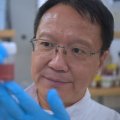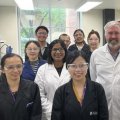Researchers at The University of Queensland Diamantina Institute and their international collaborators will continue unravelling the mechanisms underlying a particular type of early-onset arthritis, thanks to a multi-million dollar grant.
The American National Institute of Arthritis and Musculoskeletal and Skin Diseases confirmed a USD4 million grant for researchers to identify further genetics associated with ankylosing spondylitis, a debilitating form of arthritis affecting up to 100,000 Australians.
The University of Queensland Diamantina Institute director Professor Matt Brown said the grant would help build on research that was already making an impact.
“Over the first five years of this program, our genetic discoveries have identified over 40 new genetic variants involved in AS,” Professor Brown said.
“These findings have revolutionised research in the disease, and have already led to new treatments for the condition.
“We are delighted through this funding to be able to continue to work with our close North American and British collaborators in working to solve the causes of this common, under-researched disease.”
The disease causes bone material to be laid down in joints, mainly the spine and pelvis, causing pain and joint stiffness and eventually rendering the joints immovable.
Symptoms of AS can manifest as early as during adolescence, and current treatments consists of immune suppression along with pain management and reduction of the inflammation.
While these treatments are highly effective at reducing joint pain, as yet there is no treatment which has been shown to stop the progressive joint fusion that is characteristic of the disease, or to induce remission in AS.
By identifying more genes that are involved in AS and determining how they cause the condition, Professor Brown’s team hope to determine the root causes of AS, and thereby develop new therapies or preventative treatments.
“So far we have only looked at common genetic variants which make up less than 1 per cent of the genetic variation between individuals,” Professor Brown said.
“Over the next five years, using new DNA sequencing technology, we will be able to look at the rest of the genetic variants.
“This should yield another rich harvest of discoveries about the root causes of this condition.”
Genetics play a crucial role in AS, with the first marker gene for the disease, HLA-B27, discovered as early as the 1970s.
However, since only approximately 5 per cent of people with the HLA-B27 gene develop AS, other genetic factors also had to be involved.
In 2006, researchers from Australia, the UK, Canada and the US formed The Australo-Anglo-American Spondyloarthritis Consortium (or Triple ‘A’ Spondyloarthritis Consortium – TASC) to investigate various aspects of AS.
The Australian arm of TASC, led by Professor Brown, used a revolutionary technique called Genome Wide Association Scanning to detect differences in the genetic makeup of AS patients and healthy subjects.
Over the following years, TASC researchers identified more than 40 genetic variants associated with the disease, explaining about a quarter of the risk of developing the condition.
While these discoveries led to a better understanding of AS and have already contributed to new therapeutic approaches, they still do not reveal the entire picture of AS.
Building on the results obtained to date, TASC researchers will now use a different set of techniques to identify even more AS associated genes, but also to deepen their knowledge of previously identified associations.
Media: Caroline Davy at UQ Diamantina Institute (07 3176 6623, 0431 658 934 or c.davy@uq.edu.au)
.jpg)






